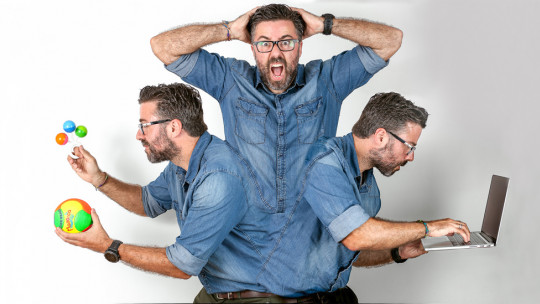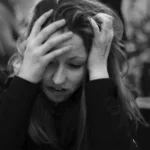The lifestyle of Western societies has caused stress to become a common phenomenon today. This condition can occur acutely, in periods when we are, for example, overworked.
However, when stress is prolonged over time, chronic stress appears (burnout or burnout syndrome in the work environment), which is even more harmful and causes negative consequences both physically and psychologically.
Stress can be classified as positive stress (eustress) or negative stress (distress). In this article We will talk about the phases of habitual stress which is considered negative, although on many occasions it helps us face the challenges of the journey, despite the fact that this generates some discomfort in the moment.
What causes stress problems?
Stress does not have a single cause, but is a multi-causal and complex phenomenon in which both internal factors come into play, such as the person’s expectations or the way the person interprets and faces the negative situations that occur around them; and external factors (for example, not having a job, experiencing economic uncertainty, or being bullied at school).
On the other hand, it is important to keep in mind that in most cases Stress is not a bad thing, much less a mental health problem. It is simply the consequence of a series of adaptation mechanisms to the environment that, through natural selection, helps us react quickly to possible risks or dangers. And in certain situations, stopping to think about what to do is a bad survival strategy, so through experiencing stress we tend to behave as if we were in a state of alert to react as quickly as possible to the slightest. a sign that delaying too much could cost us dearly.
Phenomena that cause stress are called stressors.
Work stress: a problem that affects many people
In recent decades, much research has been carried out to try to understand a form of stress that affects a large part of the population: work stress.
Data obtained through several studies show that the causes of this type of stress It’s not just workplace factors but also several factors that are unrelated to it, such as the economic crisis, cultural expectations, the poor relationship between the worker and his partner, etc.
Furthermore, recent research states that stress It occurs at various levels, not only individual but also collective. Individuals share emotional experiences, and both these emotional experiences and experiences of stress can be contagious.
Its consequences
The negative consequences of distress are numerous; however, it is important highlight the differences between acute stress and chronic stress.
The first occurs at specific moments and temporarily, in response to the experience of one or several highly stressful events. For example, due to an exam that has to be prepared in a week when the person has had the whole year to do it. As a result, the individual may suffer from anxiety, muscle pain, headaches, exhaustion, gastric problems, tachycardia, etc. This type of stress is less severe, and over time the body returns to normal.
But when stress is chronic the consequences are even more harmful causing physical, emotional or mental exhaustion and causing general damage to the health of the affected person, especially through the weakening of the immune system.
Additionally, chronic stress produces changes in self-esteem. Imagine a person who has been unemployed for several years and has financial problems; When the stressor occurs again and again repeatedly, the person can reach a serious situation of demoralization.
Some consequences of long-term negative stress are:

Phases of stress: what are they?
One of the pioneers in stress research was Hans Selye who carried out his studies in the 1950s. Today, his theory continues to be of great importance when analyzing the evolution of this psychological and physiological phenomenon.
According to this author, the stress response consists of three different phases:
1. Reaction alarm
Any physical, emotional or mental alteration consequence of having detected a threat or having encountered a stressor causes an instant reaction aimed at combating this situation. This response is called the “fight or flight” reaction, and consists of the release of adrenaline to different parts of the body: the blood vessels, the heart, the stomach, the lungs, the eyes, the muscles…
When faced with a stressful stimulus, this hormone provides a quick boost so that our energy increases so we can escape danger. We notice the effects because breathing, pulse and heart rate accelerate so that the muscles respond more quickly. Pupils dilate, blood circulates faster and this moves away from the digestive system to avoid vomiting.
In addition to these physiological functions, adrenaline also affects the brain, which is put into alert mode: attention is narrowed and we are more sensitive to any stimulus. Adrenaline, in addition to being a hormone, is also a neurotransmitter that acts in our brain.
In this phase, the level of cortisol also increases and, as a consequence, the amount of sugar in the blood increases and the immune system is weakened to save energy and help the metabolism of fats, proteins and carbohydrates. The release of these hormones can be beneficial for the body in some cases, but in the long term the consequences are extremely harmful.
2. Resistance
In the resistance stage, the body tries to adapt thanks to a process called homeostasis, which gives rise to a recovery and repair phase. Cortisol and adrenaline return to normal levels, but resources are depleted and the defenses and energy necessary for the previous phase of stress decrease. The body has overexerted itself and now must rest.
The problem arises when the stressful situation or stimulus does not stop or continually reappears, because fatigue, sleep problems and general discomfort can manifest. As a result, the person becomes very irritable and has great difficulty concentrating or being productive in their daily lives.
3. Exhaustion
When stress lasts a long time, the body ends up exhausting resources and gradually loses the adaptive capacity of the previous phases. The body weakens and, after some time in this harmful situation, the body can succumb to the disease whether it is a viral or bacterial infection, because your defenses have been exhausted. All the negative effects of chronic stress mentioned above manifest themselves at this stage.
If you want to delve deeper into chronic stress, you may be interested in the following articles:
- “Chronic stress: causes, symptoms and treatment”
- “Burnout: how to detect it and take action”
The five phases of negative stress
Research has continued over the years, and recently, the Canadian Institute of Stress, after studying thousands of people with negative stress, states that there are five phases of distress :
Phase 1: Physical and/or mental fatigue
In this phase the person experiences the first consequences of stress: a loss of vitality and the appearance of fatigue tiredness, drowsiness, demotivation… For example, when someone comes home from work in this phase, all they want is to disconnect and lie down on the couch.
Phase 2: Interpersonal problems and emotional disengagement
In this phase the person appears irritable and in a bad mood and experience problems in their personal relationships, whether with family, friends or co-workers. This creates a vicious circle, since the stressed person makes the situation even worse. The individual prefers to be alone and withdraw into himself.
Phase 3: Emotional turbulence
In this phase the person experience a pronounced emotional imbalance. The previous phase has destabilized close interpersonal relationships, creating a more tense immediate environment. As a consequence, the individual begins to doubt himself and is emotionally affected.
Phase 4: Chronic physical ailments
Stress becomes chronic and not only the mind (brain) is affected, but the body as a whole. Continued tension can cause muscle pain in the cervical, shoulder and lumbar areas, as well as headaches. In this phase, measures such as playing sports or receiving massages can be taken, but if the real stressful problem is not treated, neither the stress nor the ailments will disappear.
Phase 5: Stress-related illnesses
After a state of chronic exhaustion and depersonalization, the person begins to manifest serious physical damage. Colds, flu, ulcers, colitis, are some examples that, although they have not been directly caused by this phenomenon, cause weakening of the immune system.
The longer the stressful situation lasts, the worse the consequences will be, as hypertension, cardiovascular problems and even a heart attack may appear.
How to combat stress
Fighting stress is not an easy task, since, sometimes, we cannot control external stressors. For example, if the stressful situation is the lack of employment and the economic crisis or if our partner leaves us or makes our lives impossible.
Without a doubt, Psychological therapy becomes a good alternative to alleviate this situation because it helps develop a series of strategies and skills so that we can control the experiences and consequences that stress produces and thus reduce discomfort significantly. In addition, psychotherapy is also useful in helping us correct the way we interpret stressful events.
Stress theorists claim that stress occurs when the person does not have enough resources to deal with the situation. That is, the source of stress is found in the mismatch between existing demands and the control that the person has to face these demands. When it is not possible to eliminate the stressful stimulus or situation, providing the person with sufficient resources is a good alternative to combat stress.
Scientific studies also claim that The social environment can not only trigger the stressful situation but it can act as a buffer, reducing negative effects, and even as a way to prevent and reduce stress. At work, for example, different strategies can be used so that the relationship with colleagues is positive and, in this way, the negative impact of stress is reduced and even disappears.
In less serious cases, a series of measures can be taken to reduce stress: managing time correctly, practicing Mindfulness or exercising are some alternatives. If you want to know some tips to reduce stress, you can read this article: “10 essential tips to reduce stress.”









